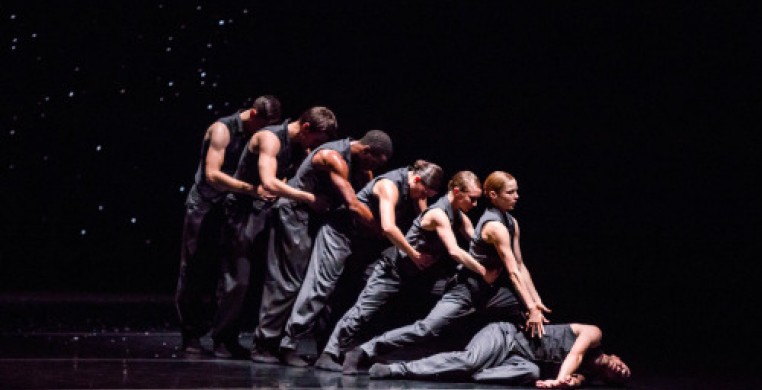It wasn’t long after the Harris Theater for Music and Dance was built that the Chicago Dancing Festival (CDF) was born. A staple venue for the entirety of the festival’s 10 years, the Harris has proved an essential partner in the week of dance freebies taking place every August in downtown Chicago. The festival opener shifted back to the big, opulent Auditorium Theatre this season, making the Harris’ 1,500 seat cavern feel somehow more intimate. Nestled between Wednesday’s “Modern Men” program at the MCA and the dance parade called Planet Chicago on Navy Pier Friday, "Dancing at the Harris" was a program for the dance generalist, offering something for everyone, all of it good.
The always popular B-boys of Rennie Harris Puremovement opened the program with the rousing 1992 “Students of the Asphalt Jungle,” a signature work of Dr. Rennie Harris. In what might be considered a formalist approach to a dance battle, several passes of phenomenal soloing by each of its shirtless men are encircled by the others, who step-touch or grapevine in the background. Harris is a master of the crowd pleaser, and “Students of the Asphalt Jungle” is no exception.
Perhaps the opposite of crowd pleaser is Martha Graham’s “Diversion of Angels.” Unlike Tuesday night’s “Appalachian Spring,” the 1948 “Diversion” is plotless. Different colored costumes are meant to represent three types of love: mature (white), erotic (red), and adolescent (yellow), with an ensemble dressed in brown. It’s hard not to applaud the skill with which the dancers execute Martha’s vocabulary, but without a story or the nostalgia of her more popular works, "Diversion" comes across as that: vocabulary.
Joffrey’s “Othello” is exactly the opposite; the act III pas de deux of CDF co-founder Lar Lubovich’s dynamic ballet on the Shakespeare tragedy, performed by Joffrey veterans April Daly and Fabrice Calmels, is brimming with drama and passion. No need for context here – we get the idea when Calmels wraps his scarf around Daly’s neck and strangles her to death. Oops, spoiler alert! Then again, don’t all Shakespeare tragedies end that way? Strangulation aside, this is a beautiful pas de deux, fittingly brought back after three years in the vault and a nice companion to the bouquet of classical duets scattered throughout the week (including Joffrey’s Victoria Jaiani and Temur Suluashvili performing Christopher Wheeldon’s “After the Rain” and Royal Ballet dancers Francesca Hayward and Marcelino Sambe in MacMillan’s balcony scene from his “Romeo & Juliet”).
An excerpt of Aszure Barton’s “Awáa” appeared three times at this year’s festival, on the Harris and Modern Men programs (on account of its three male performers) and as a late addition to Saturday's closing finale. Smart move, because everybody should see this trio. The work taps into movement vocabulary and symbolisms of the aboriginal Haida people of Canada, Barton’s native country. Fast, fluid and in a zone even Csíkszentmihályi would be proud of, “Awáa” offers some of the most compelling and tightly wound unison dancing seen lately. Please come back, and bring the whole piece.
After an opening night excerpt at the Auditorium, the Harris program closed with the full version of Crystal Pite’s hauntingly beautiful “Solo Echo,” set to Brahms and exquisitely performed by Hubbard Street Dance Chicago. Though we’ve seen this work a number of times over the past year or so, it doesn’t get old. Everything about it is magnificent.

